Dangling festive lights marking Christmas and the New Year fail to hide scars on the buildings of Belgrade, which has endured more than 40 battles throughout its troubled 7,000-year history.
Once communist leader Josip Broz Tito’s stately center of power, Beograd — “White City” in Serbian — has slowly been undergoing a face-lift after neglect since the 1990s, when NATO targeted the old Yugoslav capital over Kosovo.
Besides bombed-out towers that still stand in ruins, most buildings emerged from the 1990s with sooty frontages whose crumbling balconies and stonework pose a threat to pedestrians.
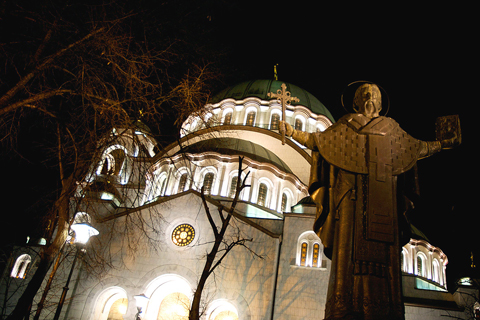
PHOTO: AFP
But the city government is beautifying Serbia’s capital in the hope tourists no longer make one of their first photo stops Kneza Milosa, the avenue lined by massive buildings that NATO’s Tomahawk cruise missiles precisely struck in 1999.
“The city is great, especially for partying, but some of the buildings need to be fixed,” said Marcus, a Swedish tourist in his 30s visiting for the first time.
Thanks to a government policy to help residents foot the bill, many streets are lined with scaffolding and workers busy sand-blasting and plastering on new facades.
“We have passed a law for the regeneration of facades — the city pays 70 percent [of the cost] and residents 30 percent. It should embellish the city in the long term,” Deputy Mayor Milan Krkobabic said.
After more than a decade of isolation under a trade blockade up until Slobodan Milosevic’s ouster in 2000, Belgrade has flourished as the engine of a country whose economy has posted growth of up to 8 percent in recent years.
Already struggling to house war refugees, Belgrade, which accounts for nearly 40 percent of Serbia’s industrial output, is bursting at its seams with an additional 30,000 job seekers each year, Krkobabic said.
Its population stood at 1.5 million in a 2001 census, but it has swelled by estimates of up to 1 million because of the influx of refugees, putting pressure notably on its residential property market and transport networks.
At least another 10,000 buildings representing 44 percent of residences were awaiting work on their facades and roofs, according to figures obtained by the state-run daily Politika.
“In the past several months, we have restored around 60 structures,” Politika quoted Boris Micanovic of the city housing authority as saying early this month.
Strategically located at the confluence of two internationally navigable rivers, Old Belgrade’s architecture reflects its turbulent past.
“As one famous architect once said: ‘There’s no more beautiful place for a city that isn’t that beautiful,’” Krkobabic said.
In the downtown area, neo-Byzantine, Ottoman Turkish and Vienna Secessionist styles are interspersed with communist-era monoliths constructed in place of historic buildings that the Nazi Luftwaffe destroyed in World War II.
“Belgrade’s face is marked with scars from past wars. The city was completely destroyed many times,” expatriate columnist Pat Andjelkovic wrote recently.
“But if you take the time to look around, you can find some striking houses that have miraculously managed to avoid fire, bombs and man’s folly,” she wrote in the newsweekly Belgrade Insight.
Many facades have since been restored with the help of old postcards, which have often helped architects to reconstruct the “ornate but often neglected ... window to the city’s soul,” Andjelkovic wrote.
“The fabulous figures, caryatids, stone heads, tile work that adorn them reflect ... the city’s soul and identity,” she said.
As well as constantly being plugged by authorities for winning the 2006 Financial Times “City of the Future” award for southeastern Europe, Belgrade has a growing reputation for its youth culture.
Around 10 percent of foreigners say they visit for fun, taking advantage of rock and Roma music festivals and New Year celebrations, the Tourist Organization of Belgrade (TOB) says.
“There are restaurants, cafes and kafanas [bistros] open all night and tourists are surprised at how relaxed they feel [despite] media obviously giving them different prejudices about Belgrade,” TOB director Jasna Dimitrijevic said.
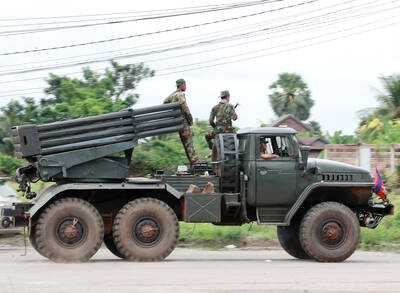
POLITICAL PATRIARCHS: Recent clashes between Thailand and Cambodia are driven by an escalating feud between rival political families, analysts say The dispute over Thailand and Cambodia’s contested border, which dates back more than a century to disagreements over colonial-era maps, has broken into conflict before. However, the most recent clashes, which erupted on Thursday, have been fueled by another factor: a bitter feud between two powerful political patriarchs. Cambodian Senate President and former prime minister Hun Sen, 72, and former Thai prime minister Thaksin Shinawatra, 76, were once such close friends that they reportedly called one another brothers. Hun Sen has, over the years, supported Thaksin’s family during their long-running power struggle with Thailand’s military. Thaksin and his sister Yingluck stayed
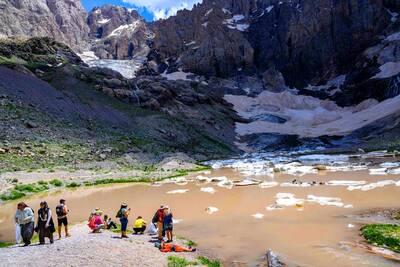
Kemal Ozdemir looked up at the bare peaks of Mount Cilo in Turkey’s Kurdish majority southeast. “There were glaciers 10 years ago,” he recalled under a cloudless sky. A mountain guide for 15 years, Ozdemir then turned toward the torrent carrying dozens of blocks of ice below a slope covered with grass and rocks — a sign of glacier loss being exacerbated by global warming. “You can see that there are quite a few pieces of glacier in the water right now ... the reason why the waterfalls flow lushly actually shows us how fast the ice is melting,” he said.
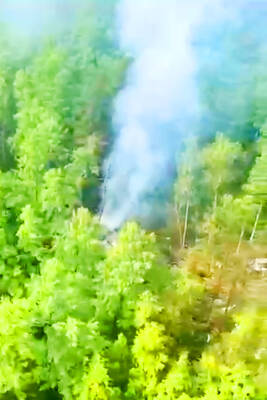
FOREST SITE: A rescue helicopter spotted the burning fuselage of the plane in a forested area, with rescue personnel saying they saw no evidence of survivors A passenger plane carrying nearly 50 people crashed yesterday in a remote spot in Russia’s far eastern region of Amur, with no immediate signs of survivors, authorities said. The aircraft, a twin-propeller Antonov-24 operated by Angara Airlines, was headed to the town of Tynda from the city of Blagoveshchensk when it disappeared from radar at about 1pm. A rescue helicopter later spotted the burning fuselage of the plane on a forested mountain slope about 16km from Tynda. Videos published by Russian investigators showed what appeared to be columns of smoke billowing from the wreckage of the plane in a dense, forested area. Rescuers in
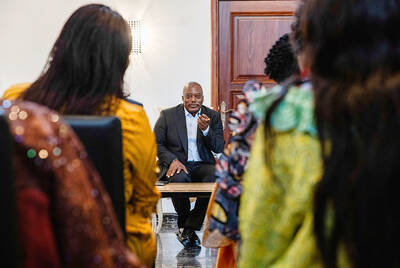
‘ARBITRARY’ CASE: Former DR Congo president Joseph Kabila has maintained his innocence and called the country’s courts an instrument of oppression Former Democratic Republic of the Congo (DR Congo) president Joseph Kabila went on trial in absentia on Friday on charges including treason over alleged support for Rwanda-backed militants, an AFP reporter at the court said. Kabila, who has lived outside the DR Congo for two years, stands accused at a military court of plotting to overthrow the government of Congolese President Felix Tshisekedi — a charge that could yield a death sentence. He also faces charges including homicide, torture and rape linked to the anti-government force M23, the charge sheet said. Other charges include “taking part in an insurrection movement,” “crime against the